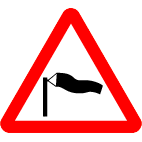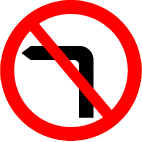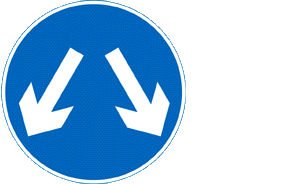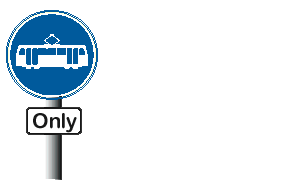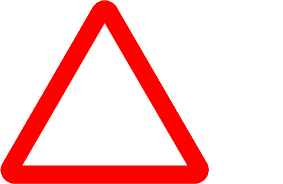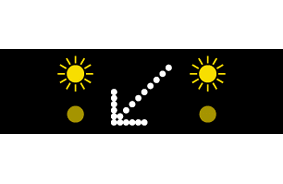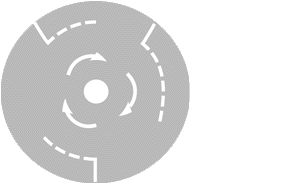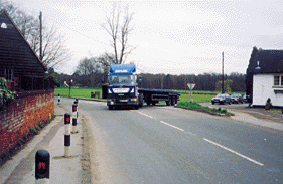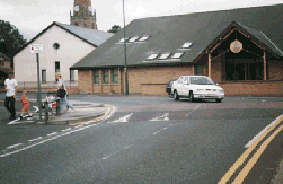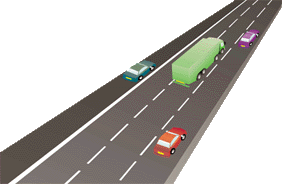This mock driving theory test consists of 50 official questions.
You need 43 out of 50 (86%) to pass. You have a time limit of 57 minutes.
Read more about the theory test and how it works.
There are no tests related to this category :
There are no tests related to this category :
Quick view of test questions. Click question box to reveal correct answer.
Correct Answer: C
Explanation: If you have to make a U-turn, slow down and ensure that the road is clear in both directions. Make sure that the road is wide enough for you to carry out the manoeuvre safely.
Explanation: If you have to make a U-turn, slow down and ensure that the road is clear in both directions. Make sure that the road is wide enough for you to carry out the manoeuvre safely.
Correct Answer: C
Explanation: These lines are often found on the approach to a roundabout or a dangerous junction. They give you extra warning to adjust your speed. Look well ahead and do this in good time.
Explanation: These lines are often found on the approach to a roundabout or a dangerous junction. They give you extra warning to adjust your speed. Look well ahead and do this in good time.
Correct Answer: A
Explanation: A motorcycle can be lost from sight behind another vehicle. The use of the headlights helps to make it more conspicuous and therefore more easily seen.
Explanation: A motorcycle can be lost from sight behind another vehicle. The use of the headlights helps to make it more conspicuous and therefore more easily seen.
4. You're about to overtake a slow-moving motorcyclist. Which one of these signs would make you take special care?
Mark one answer
AB
C
D
Correct Answer: A
Explanation: In windy weather, watch out for motorcyclists and also cyclists, as they can be blown sideways into your path. When you pass them, leave plenty of room and check their position in your mirror before pulling back in.
Explanation: In windy weather, watch out for motorcyclists and also cyclists, as they can be blown sideways into your path. When you pass them, leave plenty of room and check their position in your mirror before pulling back in.
Correct Answer: D
Explanation: Travelling at the national speed limit doesn't allow you to hog the right-hand lane. Always use the left-hand lane whenever possible. When leaving a motorway, get into the left-hand lane well before your exit. Reduce your speed on the slip road and look out for sharp bends or curves and traffic queuing at roundabouts.
Explanation: Travelling at the national speed limit doesn't allow you to hog the right-hand lane. Always use the left-hand lane whenever possible. When leaving a motorway, get into the left-hand lane well before your exit. Reduce your speed on the slip road and look out for sharp bends or curves and traffic queuing at roundabouts.
Correct Answer: C
Explanation: Toucan crossings are similar to pelican crossings but there's no flashing amber phase. Cyclists share the crossing with pedestrians and are allowed to cycle across when the green cycle symbol is shown.
Explanation: Toucan crossings are similar to pelican crossings but there's no flashing amber phase. Cyclists share the crossing with pedestrians and are allowed to cycle across when the green cycle symbol is shown.
7. You're waiting at a pelican crossing. What does it mean when the red light changes to flashing amber?
Mark one answer
AB
C
D
Correct Answer: C
Explanation: This light allows pedestrians already on the crossing to get to the other side in their own time, without being rushed. Don't rev your engine or start to move off while they're still crossing.
Explanation: This light allows pedestrians already on the crossing to get to the other side in their own time, without being rushed. Don't rev your engine or start to move off while they're still crossing.
Correct Answer: C
Explanation: There are three basic types of traffic sign: those that warn, those that inform and those that give orders. Generally, triangular signs warn, rectangular signs give information or directions, and circular signs give orders. An exception is the eight-sided 'stop' sign.
Explanation: There are three basic types of traffic sign: those that warn, those that inform and those that give orders. Generally, triangular signs warn, rectangular signs give information or directions, and circular signs give orders. An exception is the eight-sided 'stop' sign.
Correct Answer: C
Explanation: These signs are often seen in one-way streets that have more than one lane. When you see this sign, use the route that's the most convenient and doesn't require a late change of direction.
Explanation: These signs are often seen in one-way streets that have more than one lane. When you see this sign, use the route that's the most convenient and doesn't require a late change of direction.
Correct Answer: D
Explanation: Take extra care when you encounter trams. Look out for road markings and signs that alert you to them. Modern trams are very quiet and you may not hear them approaching.
Explanation: Take extra care when you encounter trams. Look out for road markings and signs that alert you to them. Modern trams are very quiet and you may not hear them approaching.
Correct Answer: D
Explanation: This type of sign warns you of hazards ahead. Make sure you look at each sign that you pass on the road, so that you don't miss any vital instructions or information.
Explanation: This type of sign warns you of hazards ahead. Make sure you look at each sign that you pass on the road, so that you don't miss any vital instructions or information.
Correct Answer: A
Explanation: On the motorway, signs sometimes show temporary warnings due to traffic or weather conditions. They may be used to indicate
- lane closures
- temporary speed limits
- weather warnings
Explanation: On the motorway, signs sometimes show temporary warnings due to traffic or weather conditions. They may be used to indicate
- lane closures
- temporary speed limits
- weather warnings
Correct Answer: C
Explanation: Sometimes an insurance company will issue a temporary insurance certificate called a cover note. It gives you the same insurance cover as your certificate but lasts for a limited period, usually one month.
Explanation: Sometimes an insurance company will issue a temporary insurance certificate called a cover note. It gives you the same insurance cover as your certificate but lasts for a limited period, usually one month.
14. You're turning right at a crossroads. An oncoming driver is also turning right. How should you normally deal with this?
Mark one answer
AB
C
D
Correct Answer: D
Explanation: At crossroads, traffic normally turns offside to offside. This is the safest way to turn, but sometimes the layout or road markings indicate drivers should pass nearside to nearside. Take extra care at these crossroads because, as you turn, your view ahead will be obscured by the oncoming vehicle crossing in front of you.
Explanation: At crossroads, traffic normally turns offside to offside. This is the safest way to turn, but sometimes the layout or road markings indicate drivers should pass nearside to nearside. Take extra care at these crossroads because, as you turn, your view ahead will be obscured by the oncoming vehicle crossing in front of you.
15. You're waiting at a level crossing. A train passes but the lights keep flashing. What must you do?
Mark one answer
AB
C
D
Correct Answer: A
Explanation: If the lights at a level crossing keep flashing after a train has passed, you should continue to wait, because another train might be coming. Time seems to pass slowly when you're held up in a queue. Be patient and wait until the lights stop flashing.
Explanation: If the lights at a level crossing keep flashing after a train has passed, you should continue to wait, because another train might be coming. Time seems to pass slowly when you're held up in a queue. Be patient and wait until the lights stop flashing.
16. You're following a slower-moving vehicle on a narrow country road. There's a junction just ahead on the right. What should you do?
Mark one answer
AB
C
D
Correct Answer: B
Explanation: You should never overtake as you approach a junction. If a vehicle emerged from the junction while you were overtaking, a dangerous situation could develop very quickly.
Explanation: You should never overtake as you approach a junction. If a vehicle emerged from the junction while you were overtaking, a dangerous situation could develop very quickly.
A
B
C
D
B
C
D
Correct Answer: C
Explanation: In good conditions, the 'two-second rule' can be used to check the distance between your vehicle and the one in front. This technique works on roads carrying faster traffic. Choose a fixed object, such as a bridge, sign or tree. When the vehicle ahead passes this object, say to yourself 'Only a fool breaks the two-second rule.' If you reach the object before you finish saying this, you're too close.
Explanation: In good conditions, the 'two-second rule' can be used to check the distance between your vehicle and the one in front. This technique works on roads carrying faster traffic. Choose a fixed object, such as a bridge, sign or tree. When the vehicle ahead passes this object, say to yourself 'Only a fool breaks the two-second rule.' If you reach the object before you finish saying this, you're too close.
18. A driver's behaviour has upset you. What can you do to safely get over this incident?
Mark one answer
AB
C
D
Correct Answer: D
Explanation: If you feel yourself becoming tense or upset, stop in a safe place and take a break. Tiredness can make things worse and may cause a different reaction to upsetting situations.
Explanation: If you feel yourself becoming tense or upset, stop in a safe place and take a break. Tiredness can make things worse and may cause a different reaction to upsetting situations.
19. What should you do when you're approaching a bus that's signalling to move away from a bus stop?
Mark one answer
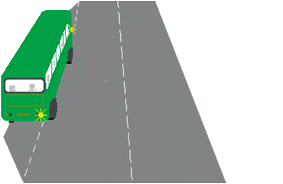
B
C
D
Correct Answer: A
Explanation: Try to give way to buses if you can do so safely, especially when the driver signals to pull away from a bus stop. Look out for people getting off the bus or running to catch it, because they may cross the road without looking. Don't accelerate to get past the bus, and don't flash your lights, as this could mislead other road users.
Explanation: Try to give way to buses if you can do so safely, especially when the driver signals to pull away from a bus stop. Look out for people getting off the bus or running to catch it, because they may cross the road without looking. Don't accelerate to get past the bus, and don't flash your lights, as this could mislead other road users.
20. You're in the right-hand lane of a three-lane motorway. What do these overhead signs mean?
Mark one answer

B
C
D
Correct Answer: B
Explanation: You must obey these signs even if there appear to be no problems ahead. There could be queuing traffic or another hazard which you can't yet see.
Explanation: You must obey these signs even if there appear to be no problems ahead. There could be queuing traffic or another hazard which you can't yet see.
21. The dual carriageway you're turning right onto has a very narrow central reservation. What should you do?
Mark one answer
AB
C
D
Correct Answer: D
Explanation: When the central reservation is narrow, you should treat a dual carriageway as one road. Wait until the road is clear in both directions before emerging to turn right. If you try to treat it as two separate roads and wait in the middle, you're likely to cause an obstruction and possibly a collision.
Explanation: When the central reservation is narrow, you should treat a dual carriageway as one road. Wait until the road is clear in both directions before emerging to turn right. If you try to treat it as two separate roads and wait in the middle, you're likely to cause an obstruction and possibly a collision.
Correct Answer: A
Explanation: These markings show the direction in which the traffic should go at a mini-roundabout.
Explanation: These markings show the direction in which the traffic should go at a mini-roundabout.
23. You're on a dual carriageway. Ahead, you see a vehicle with an amber flashing light. What could this be?
Mark one answer
AB
C
D
Correct Answer: A
Explanation: An amber flashing light on a vehicle indicates that it's slow-moving. Battery-powered vehicles used by disabled people are limited to 8 mph. It isn't advisable for them to be used on dual carriageways where the speed limit exceeds 50 mph. If they are, then an amber flashing light must be used.
Explanation: An amber flashing light on a vehicle indicates that it's slow-moving. Battery-powered vehicles used by disabled people are limited to 8 mph. It isn't advisable for them to be used on dual carriageways where the speed limit exceeds 50 mph. If they are, then an amber flashing light must be used.
24. Some junctions controlled by traffic lights have a marked area between two stop lines. What's this for?
Mark one answer
AB
C
D
Correct Answer: B
Explanation: These are known as advanced stop lines. When the lights are red (or about to become red), you should stop at the first white line. However, if you've crossed that line as the lights change, you must stop at the second line even if it means you're in the area reserved for cyclists.
Explanation: These are known as advanced stop lines. When the lights are red (or about to become red), you should stop at the first white line. However, if you've crossed that line as the lights change, you must stop at the second line even if it means you're in the area reserved for cyclists.
Correct Answer: B
Explanation: To go straight ahead at a roundabout, you should normally approach in the left-hand lane, but check the road markings. At some roundabouts, the left lane on approach is marked 'left turn only', so make sure you use the correct lane to go ahead. You won't normally need to signal as you approach, but signal before you leave the roundabout, as other road users need to know your intentions.
Explanation: To go straight ahead at a roundabout, you should normally approach in the left-hand lane, but check the road markings. At some roundabouts, the left lane on approach is marked 'left turn only', so make sure you use the correct lane to go ahead. You won't normally need to signal as you approach, but signal before you leave the roundabout, as other road users need to know your intentions.
Correct Answer: A
Explanation: At a crash scene you can help in practical ways, even if you aren't trained in first aid. Call the emergency services and make sure you don't put yourself or anyone else in danger. The safest way to warn other traffic is by switching on your hazard warning lights.
Explanation: At a crash scene you can help in practical ways, even if you aren't trained in first aid. Call the emergency services and make sure you don't put yourself or anyone else in danger. The safest way to warn other traffic is by switching on your hazard warning lights.
27. At an incident, a casualty isn't breathing. What should you do while helping them to start breathing again?
Mark one answer
AB
C
D
Correct Answer: D
Explanation: It's important to ensure that the airways are clear before you start mouth-to-mouth resuscitation. Gently tilt their head back and use your finger to check for and remove any obvious obstruction in the mouth.
Explanation: It's important to ensure that the airways are clear before you start mouth-to-mouth resuscitation. Gently tilt their head back and use your finger to check for and remove any obvious obstruction in the mouth.
Correct Answer: C
Explanation: If you feel yourself becoming tired or sleepy, you should leave the motorway at the next exit or services and stop for a rest. If you have to drive a long way, leave earlier and plan your journey to include rest stops. That way, you're less likely to become tired while driving and you'll still arrive in good time.
Explanation: If you feel yourself becoming tired or sleepy, you should leave the motorway at the next exit or services and stop for a rest. If you have to drive a long way, leave earlier and plan your journey to include rest stops. That way, you're less likely to become tired while driving and you'll still arrive in good time.
29. You're about to drive home. You feel very tired and have a severe headache. What should you do?
Mark one answer
AB
C
D
Correct Answer: D
Explanation: All of your concentration should be on your driving. Any pain you feel will distract you, and you should avoid driving when drowsy. The safest course of action is to wait until you've rested and are feeling better before starting your journey.
Explanation: All of your concentration should be on your driving. Any pain you feel will distract you, and you should avoid driving when drowsy. The safest course of action is to wait until you've rested and are feeling better before starting your journey.
Correct Answer: B
Explanation: It may not be possible to see a small child through the rear windscreen of your vehicle. Be aware of this before you reverse. If there are children about, get out and check that it's clear before reversing.
Explanation: It may not be possible to see a small child through the rear windscreen of your vehicle. Be aware of this before you reverse. If there are children about, get out and check that it's clear before reversing.
31. Your car gets a puncture while you're driving on the motorway. You get it onto the hard shoulder. What should you do?
Mark one answer
AB
C
D
Correct Answer: D
Explanation: Park as far to the left as you can and leave the vehicle by the nearside door. Don't attempt even simple repairs. Instead, walk to an emergency telephone on your side of the road and phone for help. While waiting for help to arrive, stay by your car, keeping well away from the carriageway and hard shoulder.
Explanation: Park as far to the left as you can and leave the vehicle by the nearside door. Don't attempt even simple repairs. Instead, walk to an emergency telephone on your side of the road and phone for help. While waiting for help to arrive, stay by your car, keeping well away from the carriageway and hard shoulder.
Correct Answer: B
Explanation: When there's queuing traffic ahead and you have to slow down or even stop, briefly showing your hazard warning lights will help alert following traffic to the hazard.
Explanation: When there's queuing traffic ahead and you have to slow down or even stop, briefly showing your hazard warning lights will help alert following traffic to the hazard.
33. What should you do if a trailer starts to swing from side to side while you're towing it?
Mark one answer
AB
C
D
Correct Answer: C
Explanation: Strong winds or buffeting from large vehicles can cause a trailer or caravan to swing from side to side ('snake'). If this happens, ease off the accelerator. Don't brake harshly, steer sharply or increase your speed.
Explanation: Strong winds or buffeting from large vehicles can cause a trailer or caravan to swing from side to side ('snake'). If this happens, ease off the accelerator. Don't brake harshly, steer sharply or increase your speed.
Correct Answer: B
Explanation: If you don't have your vehicle serviced regularly, the engine will gradually become less efficient. This will cause increased fuel consumption and, in turn, an increase in the amount of harmful emissions it produces.
Explanation: If you don't have your vehicle serviced regularly, the engine will gradually become less efficient. This will cause increased fuel consumption and, in turn, an increase in the amount of harmful emissions it produces.
35. You're driving along a country road. You see this sign. What should you do after dealing safely with the hazard?
Mark one answer

B
C
D
Correct Answer: D
Explanation: If your brakes have been thoroughly soaked, you should check that they're working properly before you build up speed again. Before you do this, remember to check your mirrors and consider what's behind you.
Explanation: If your brakes have been thoroughly soaked, you should check that they're working properly before you build up speed again. Before you do this, remember to check your mirrors and consider what's behind you.
36. You take the wrong route and find you're on a one-way street. What should you do?
Mark one answer
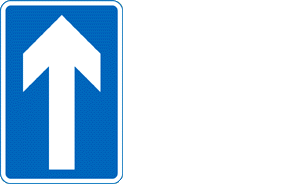
B
C
D
Correct Answer: A
Explanation: Never reverse or turn your vehicle around in a one-way street. It's illegal and could even cause a collision. If you've taken a wrong turn, carry on along the one-way street and find another route, checking the direction signs as you drive. Stop in a safe place if you need to check a map.
Explanation: Never reverse or turn your vehicle around in a one-way street. It's illegal and could even cause a collision. If you've taken a wrong turn, carry on along the one-way street and find another route, checking the direction signs as you drive. Stop in a safe place if you need to check a map.
Correct Answer: B
Explanation: Sometimes, large vehicles may need more space than other road users. If a vehicle needs more time and space to turn, be prepared to stop and wait.
Explanation: Sometimes, large vehicles may need more space than other road users. If a vehicle needs more time and space to turn, be prepared to stop and wait.
Correct Answer: B
Explanation: An unlocked car is an open invitation to thieves. Leaving the keys in the ignition not only makes your car easy to steal but could also invalidate your insurance.
Explanation: An unlocked car is an open invitation to thieves. Leaving the keys in the ignition not only makes your car easy to steal but could also invalidate your insurance.
39. Why could it be dangerous to keep the clutch down, or select neutral, for long periods of time while you're driving?
Mark one answer
AB
C
D
Correct Answer: D
Explanation: Letting your vehicle roll or coast in neutral reduces your control over steering and braking. This can be dangerous on downhill slopes, where your vehicle could pick up speed very quickly.
Explanation: Letting your vehicle roll or coast in neutral reduces your control over steering and braking. This can be dangerous on downhill slopes, where your vehicle could pick up speed very quickly.
Correct Answer: D
Explanation: The humps are there for a reason - to protect vulnerable road users by reducing the speed of traffic. Don't accelerate harshly between the humps. Put the safety of others first and maintain a reduced speed throughout the zone.
Explanation: The humps are there for a reason - to protect vulnerable road users by reducing the speed of traffic. Don't accelerate harshly between the humps. Put the safety of others first and maintain a reduced speed throughout the zone.
A
B
C
D
B
C
D
Correct Answer: A
Explanation: Motorcyclists and cyclists are often more difficult to see at junctions. They're easily hidden from view and you may not be able to see them approaching a junction if your view is partially blocked; for example, by other traffic.
Explanation: Motorcyclists and cyclists are often more difficult to see at junctions. They're easily hidden from view and you may not be able to see them approaching a junction if your view is partially blocked; for example, by other traffic.
42. You find that your eyesight has become very poor and your optician cannot help you. By law, who should you tell?
Mark one answer
AB
C
D
Correct Answer: B
Explanation: Having very poor eyesight will have a serious effect on your ability to drive safely. If you can't meet the driver's eyesight requirements, you must tell DVLA (or DVA in Northern Ireland).
Explanation: Having very poor eyesight will have a serious effect on your ability to drive safely. If you can't meet the driver's eyesight requirements, you must tell DVLA (or DVA in Northern Ireland).
43. When driving a car fitted with automatic transmission, what would you use 'kick down' for?
Mark one answer
AB
C
D
Correct Answer: C
Explanation: Kick down' selects a lower gear, enabling the vehicle to accelerate faster.
Explanation: Kick down' selects a lower gear, enabling the vehicle to accelerate faster.
Correct Answer: B
Explanation: Always switch off the engine, remove the key and lock your car, even if you're only leaving it for a few minutes.
Explanation: Always switch off the engine, remove the key and lock your car, even if you're only leaving it for a few minutes.
Correct Answer: C
Explanation: Don't park your vehicle where it may obstruct access to a business or property. Think carefully before you slow down and stop. Look at road markings and signs to ensure that you aren't parking illegally.
Explanation: Don't park your vehicle where it may obstruct access to a business or property. Think carefully before you slow down and stop. Look at road markings and signs to ensure that you aren't parking illegally.
46. While you're driving in fog, it becomes necessary to use front fog lights. What should you remember?
Mark one answer
AB
C
D
Correct Answer: D
Explanation: It's illegal to use your fog lights in conditions other than when visibility is seriously reduced; that is, less than 100 metres (328 feet). Fog lights are very bright and, if you use them when visibility has improved, you could dazzle other drivers.
Explanation: It's illegal to use your fog lights in conditions other than when visibility is seriously reduced; that is, less than 100 metres (328 feet). Fog lights are very bright and, if you use them when visibility has improved, you could dazzle other drivers.
A
B
C
D
B
C
D
Correct Answer: B
Explanation: If any object falls onto the motorway carriageway from your vehicle, pull onto the hard shoulder near an emergency telephone and call for assistance. Don't stop on the carriageway or attempt to retrieve anything.
Explanation: If any object falls onto the motorway carriageway from your vehicle, pull onto the hard shoulder near an emergency telephone and call for assistance. Don't stop on the carriageway or attempt to retrieve anything.
Correct Answer: B
Explanation: Missing out intermediate gears, when appropriate, helps to reduce the amount of time spent accelerating and decelerating - the times when your vehicle uses the most fuel.
Explanation: Missing out intermediate gears, when appropriate, helps to reduce the amount of time spent accelerating and decelerating - the times when your vehicle uses the most fuel.
49. You're carrying a child in your car. They're under three years old. Which of these is a suitable restraint?
Mark one answer
AB
C
D
Correct Answer: A
Explanation: It's your responsibility to ensure that all children in your car are secure. Suitable restraints include a child seat, baby seat, booster seat or booster cushion. It's essential that any restraint used is suitable for the child's size and weight, and fitted according to the manufacturer's instructions.
Explanation: It's your responsibility to ensure that all children in your car are secure. Suitable restraints include a child seat, baby seat, booster seat or booster cushion. It's essential that any restraint used is suitable for the child's size and weight, and fitted according to the manufacturer's instructions.
Correct Answer: C
Explanation: You should only stop on the hard shoulder in a genuine emergency. Don't stop there to have a rest or picnic, pick up hitchhikers, answer a mobile phone or check a map. If you miss your intended exit, carry on to the next. Never reverse along the hard shoulder.
Explanation: You should only stop on the hard shoulder in a genuine emergency. Don't stop there to have a rest or picnic, pick up hitchhikers, answer a mobile phone or check a map. If you miss your intended exit, carry on to the next. Never reverse along the hard shoulder.



